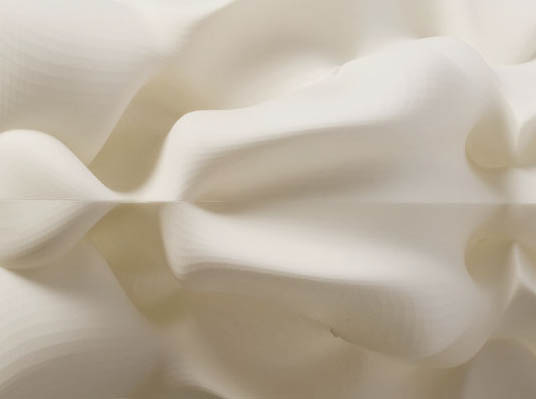Neri Oxman
Imagine a chair that moves when you move, that adjusts to every muscle in your body, that responds like a living organism . . . a chair kind of like a really excellent lover. Neri Oxman imagined such a chair. Then she built it. The result was Beast, the chaise lounge that the young designer built in collaboration with MIT professor Craig Carter. She describes it as being “all about an efficiency of material, distributing it according to your body load.” Resembling a praying mantis, the Beast chair is a prime example of the “living-synthetic constructions” that Oxman is becoming famous for. In short, her works are a complex recipe of design, science, art, and environmentalism, and it’s often hard to tell where one field ends and the other picks up.
Raised in Haifa and Caesarea, Israel, by architect parents, Oxman rebelled (well, by academic standards anyway) by going into medicine, completing med school at the Hebrew University of Jerusalem. But she couldn’t squelch her interest in design, and so she ventured to London to get a degree from the Architectural Association School of Architecture before enrolling in the PhD program in design computation at MIT. As a designer, the current grad student has a rather simple philosophy: to change the world by proving how technology can live in harmony with nature. “It’s a love affair with design that is continuously being nurtured by reaching into other disciplines, then coming back to design with those different points of view,” she explains.
Oxman usually looks to nature for practical design answers. Her work integrates the principles of biomimicry with manmade objects—think buildings that can “breath and sweat and think and grow and change,” she says. Recently at MoMA, she even showed a series of hive-like sculptures made of wood, acrylic, and nylon that actually respond to light, heat, and weight like living tissue. Such experiments are more than aesthetic: They could point to the future of energy-efficient building materials. Not surprisingly, there’s just as much public interest in what Oxman’s ideas mean on a larger scale as there is in the scale models she’s already constructed. Thus, most of her products and prototypes aren’t very commercially viable. “I hope that they will be one day,” she says. “But if I needed to live in a tent and continue thinking about innovation, I would probably choose that option.”
As for her own future, she rejects any possibility of a Neri Oxman line of roof tiles or a collaboration on Andre Balazs’s next hotel. Ideally, she would direct others in her art-design-ecology practice. “A great dream of mine would be to run a design studio full of scientists who think about science as creatively as if they were doing art,” she says. Oxman isn’t so taken with architecture and design whose only revolution lies on the surface. “Forget about the way it looks,” she says. “Think about how it behaves.”
To learn more about Neri Oxman’s work, visit her Web site and blog.







